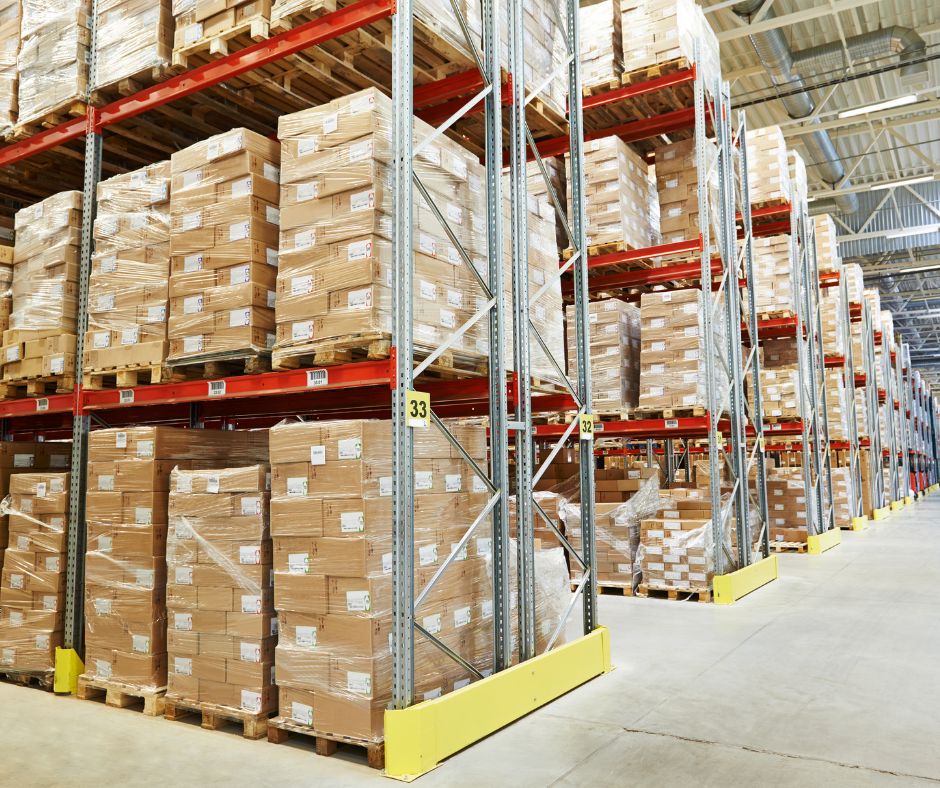Logistics and supply chain management is a fast-paced industry, and at the heart of any successful warehouse operation is material handling. Mastering warehouse material handling is the key to staying ahead of the curve and here’s why.
Efficient material handling directly impacts the bottom line. It reduces operational costs, minimizes waste, and ensures that you’re not paying for wasted space or time. This leads to quicker order fulfillment which results in happier, more satisfied returning customers.
You will not have to worry about safety, organization, or inventory control as proper management eliminates risk, misplacement, or damaged goods as well as makes the best use of your warehouse space. With this established, you’ll be able to meet your customer demands and have an edge over competition
Temp Staffing Inc. can help you create a well-oiled, cost-effective, and customer-friendly machine that operates in an increasingly complex business world. We staff a variety of industries and will find the right match for you.
Choosing the Right Equipment
Each piece of equipment plays a pivotal role in shaping the efficiency, safety, and productivity of your warehouse. Choosing the right equipment can make or break a warehouse material handling system, so don’t rush into these decisions. Take the time to evaluate your unique needs and objectives.
Pallet Racks and Shelving Systems
Pallet racks and shelving systems are your go-to solutions for capitalizing on vertical storage. They are versatile, accessible, and durable. They also present safety features like guardrails and secure anchoring to prevent accidents. They can be optimized as needed and can be tailored to accommodate various goods whether you’re storing small items, large pallets, or odd-shaped merchandise.
Conveyor Systems
Conveyor systems smoothly move goods from point to point, reducing manual handling. It’s important to select the conveyor type that best fits your specific needs and ensure that they are seamlessly integrated into your warehouse material handling system. This is especially advantageous for needed maintenance and efficiency.
Forklifts and Other Warehouse Material Handling Equipment
There are numerous types of forklifts to consider. They can be electric, propane, or diesel so it’s important to choose the one that aligns with your warehouse’s needs and budget. You will also need to consider its lifting capacity and height to your inventory’s weight and stacking requirements as well as the maneuverability of your warehouse layout.
It’s important to prioritize the safety features of your warehouse material handling equipment and ensure that your operators are adequately trained and certified in compliance with safety regulations.
Inventory Management
Effective inventory management is the art of balancing supply and demand, optimizing resources, and keeping customers satisfied. Temp Staffing Inc. can help you achieve a successful operation through the following implementations.
Implementing an Inventory Control System

An inventory control system helps you centralize data, making it easy to track, manage, and access critical information. This type of system allows you to make quick decisions in real time while using historical data and analysts to predict demand so that you always have the right amount of stock on hand.
This warehouse material handling system also works well with automation to reduce human error and expedite routine tasks, and so will be implementing technologies like barcoding and RFID.
ABC Analysis for Prioritizing Products
This is a strategic prioritization of your products into A, B, and C groups based on their value or sales volume. This allows you to devote more attention to high-value items while minimizing the carrying costs of lower-value items. It’s important to maintain a balance to optimize your inventory, which is achieved by reviewing and updating your categorization as market dynamics change.
Regular Audits and Cycle Counts
Regular audits and cycle counts verify that your recorded inventory matches what’s physically present in your warehouse. By doing this you will be able to catch discrepancies, inaccuracies, or theft before they become major issues. The establishment of these baselines keeps operations running smoothly, ensures staff are performing, prevents costly disruptions, ensures your data is reliable, and that your warehouse material handling system stays compliant with industry regulations and accounting standards.
Storage Strategies
Mastering storage strategies directly implants the order and efficiency within your warehouse. Choosing the right method, and techniques and finding the right balance in storage will ensure your warehouse operates like a finely tuned instrument. Here are a few things to consider to achieve these results.
FIFO and LIFO Methods
FIFO, or “First-In, First-Out,” ensures that the oldest inventory is the first to be picked. This guarantees freshness and minimizes obsolescence. LIFO, or “Last-In, First-Out,” on the other hand, means the most recently received inventory is picked first. It can be advantageous for certain businesses, especially when dealing with non-perishable goods.
This goes without saying that you should choose the one that aligns with your product type and industry. The right choice will help your warehouse for quick and easy access to the right stock while saving you from losses due to expired items.
Cross-Docking Techniques
Cross-docking is like a hub for goods, where they are quickly sorted and transferred to outbound vehicles without long-term storage. It reduces the need for warehousing and storage space, thereby minimizing handling costs and speeding up order fulfillment. Cross-docking is ideal for businesses that rely on just-in-time inventory management, as it ensures that your goods arrive and leave promptly.
You can integrate advanced tracking and communication systems which are crucial for seamless cross-docking operations. Also, consider collaborating closely with suppliers to receive goods when needed and maintain a steady flow of products through your cross-docking center.
Bulk and Rack Storage Comparison
Bulk storage is where you pile up goods in one area, and is ideal for items that don’t require individual picking. It maximizes storage space and is cost-effective. Rack storage is like a library where products are neatly organized on shelves, making it easier to locate and pick items individually. The warehouse material handling storage that you choose should be determined by the frequency with which you need access to these items. Bulk storage works for slow-moving goods, while rack storage suits fast-moving inventory.
The type of storage also determines how the warehouse material handling space will be used. Racks are space-efficient but may not be cost-effective for bulk items, while bulk storage might save space but at the cost of accessibility. The in-between would be a hybridized approach that combines bulk and rack storage to strike a balance between space utilization and accessibility.
Packaging and Labeling

Packaging and labeling aren’t just functional aspects of your product, by choosing the right materials, creating effective labels, and embracing sustainable packaging options, you can not only protect your product but also delight your customers and showcase your commitment to the planet.
Choosing Appropriate Packaging Materials
The choice of packaging material matters. Cardboard, plastic, glass, or even eco-friendly options like biodegradable materials – each has its purpose and charm. The materials that you select should ensure your product’s integrity during both transit and storage. To minimize movement inside and the risk of breakage or leakage you will need to tailor the packaging to fit your product snugly.
Branded packaging is an opportunity to use colors, patterns, and designs that reflect your brand identity and catch the customer’s eye. But ensure that you choose materials that strike a balance between protection and cost so that it doesn’t eat into your profits.
Effective Labeling for Easy Identification
Your labels should be clear and legible, and convey essential information at a glance. Your product name, usage instructions, and any required safety warnings should be easy to spot. For global markets, you should consider labels with information in multiple languages to ensure inclusivity and compliance with regulations.
To reinforce your brand’s identity and create a cohesive product lineup it’s important to maintain a consistent visual theme with your labels. You can also save time and reduce errors during stock-keeping by implementing scannable codes. Labels can be a great tool for encouraging customers to reuse or recycle packaging. This message should be communicated clearly on the label.
Sustainable Packaging Options
You should not hesitate to consider options like recyclable, biodegradable, or compostable materials to minimize environmental impact. A package designed to reduce excess material will also promote reusability and minimize packaging waste. Your aim should be to inform consumers about the eco-friendliness of your packaging and to encourage them to recycle or upcycle it.
You can achieve this by displaying eco-certifications on your packaging to demonstrate your commitment to sustainability. Just be sure to evaluate the sustainability of your entire supply chain, from material sourcing to transportation and disposal.
Loading and Unloading
Picture a bustling warehouse. How will you ensure the safety of your workers, the security of your cargo, and the efficiency of your warehouse material handling logistics? Here are a few options.
Dock Planning and Optimization
Dock planning is the blueprint for your warehouse’s lifeline. You must ensure that your layout accommodates the types and volume of goods you handle. You will need to equip your loading bays with proper staff, as well as essential tools like dock levelers, bumpers, and lights to enhance safety and speed.
By arranging the loading and unloading areas logically, you will be able to streamline operations. Incorporating safety zones and signage ensures the well-being of workers and minimizes accidents. While syncing dock schedules with transport arrivals will prevent congestion and downtime.
Load Sequencing for Quick Dispatch
Quick dispatching starts with prioritizing loading based on destination or route to ensure timely delivery and optimized truck capacity. You will be able to create efficient stacking and organized storage by; placing heavier and bulkier items at the bottom of the load to maintain stability during transit and; in order of the destinations or customers that they are meant for.
By employing real-time tracking and documentation you’ll be able to confirm the security and accuracy of your items throughout the transit.
Handling Fragile or Hazardous Goods
Temp Staffing Inc. will ensure that the personnel handling fragile or hazardous goods have received the necessary training for safe warehouse material handling and proper use of warehouse material handling equipment.
You will need to ensure that the goods are clearly labeled to indicate fragility or hazard. Our temp staff will handle them with care, and ensure protective gear is used when necessary. We encourage you to stack fragile goods separately and securely to minimize the risk of damage during transit.
Strict adherence to regulations governing the transport of hazardous goods, including packaging and labeling requirements is necessary. The same is required when equipping your facility with safety equipment and protocols for handling accidents or spillages involving hazardous materials.
Summary
In the world of logistics and warehouse management, efficient warehouse material handling is the linchpin of success. It encompasses a range of strategies for optimizing processes and the ability to reduce costs, enhance customer satisfaction, and ultimately provide a competitive advantage in the ever-evolving world of logistics.
The last thing that you should have to worry about is staffing. Don’t worry, Temp Staffing Inc. has got you covered. We’ll provide you with the dedicated, dependable, hard-working temporary, temp-to-hire, and direct-hire employees your business needs.




